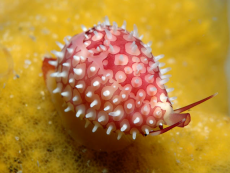
Cowries, the common name for species within the taxonomic family Cypraeidae, are sea snails with distinctive shells. The shells are rounded and oval in shape, with a long slit running along the underside containing the cowry’s ‘teeth’. The shells are typically very smooth and shiny, as they are usually covered by the animal’s mantle. This is the name for the main body section of a mollusc, and in the cowry’s case can be retracted back into its shell. Cowries’ mantles are covered in papillae, or small lumps, which aid respiration and add camouflage. Cowries range from 5mm in length, to 19cm. The largest cowry is the Macrocypraea cervus, or Atlantic deer cowry, found in the tropical Atlantic Ocean.
As a result of their effective camouflage and nocturnal sleep cycles, the eating habits of cowries are not very well known. However, their most commonly cited prey is the sea sponge; a cowry’s mantle colour sometimes matches that of the sponge it feeds on. The narrow opening into a cowry’s shell makes it difficult for predators to reach in to the animal inside. However, some animals can break open the shell, such as large crustaceans and octopuses.
Female cowries lay small egg capsules and sit on top of them until they hatch. Juvenile cowries don’t resemble adults at all and have completely different, conical-shaped shells. They also have different colour markings, and it can be very difficult to identify them correctly.

Throughout history humans have been attracted to cowries’ shells for their shiny appearance and pleasing shapes. In fact, the word porcelain comes from the old Italian word for a cowry’s shell: porcellana. Cowry shells have been used as jewellery, for decoration, and even as money! The small, 3cm, shells of the species Monetaria moneta, or money cowry, were historically used as a currency in many Pacific and Indian Ocean countries. A unit of Ghana’s currency today, the Ghanaian cedi, is named after the word for a cowry, while the Classical Chinese character for money (貝) originated as a stylised drawing of a cowry shell.
In other countries small cowry shells are used as counters for games. They are used as part of a popular gambling game in Nepal, often as part of the Hindu Diwali festival. In India cowries can be used as dice, with several shells thrown and the number landing aperture-up counted. The shells have other practical uses too. The large shell of the Cypraea tigris, or tiger cowry, was used as a darning egg in Europe, to stitch socks! This and other species of cowry are associated with womanhood and fertility. Japanese women sometimes hold a tiger cowry shell while giving birth, to bring good luck.
Above all, cowry shells are prized for their beautiful patterns, and have often been used in jewellery or as charms. In Fiji the shell of a Lyncina aurantium, or golden cowry, was worn by chieftains as a badge of rank. Cowry shells are still a commonly collected item, and can be worth a lot of money. The Hawaii-native Cypraea ostergaardi, or Ostergaard’s Cowry, is worth several thousand dollars!
Images: http://www.daveharasti.com/nelsonbay/cowries/Diminovula_wilsoniana.jpg
https://upload.wikimedia.org/wikipedia/commons/6/6f/Different_cowries.jpg

0 Comment:
Be the first one to comment on this article.